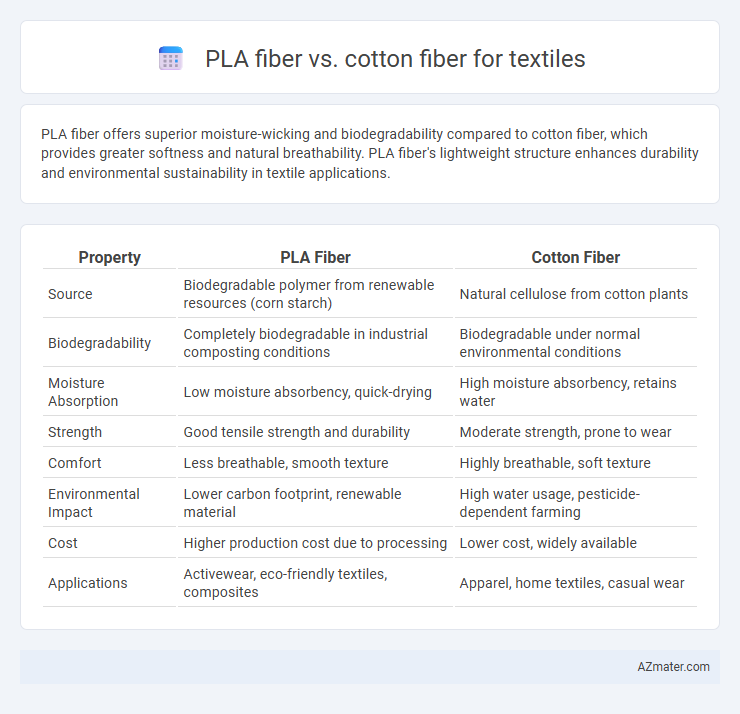PLA fiber offers superior moisture-wicking and biodegradability compared to cotton fiber, which provides greater softness and natural breathability. PLA fiber's lightweight structure enhances durability and environmental sustainability in textile applications.
Table of Comparison
| Property | PLA Fiber | Cotton Fiber |
|---|---|---|
| Source | Biodegradable polymer from renewable resources (corn starch) | Natural cellulose from cotton plants |
| Biodegradability | Completely biodegradable in industrial composting conditions | Biodegradable under normal environmental conditions |
| Moisture Absorption | Low moisture absorbency, quick-drying | High moisture absorbency, retains water |
| Strength | Good tensile strength and durability | Moderate strength, prone to wear |
| Comfort | Less breathable, smooth texture | Highly breathable, soft texture |
| Environmental Impact | Lower carbon footprint, renewable material | High water usage, pesticide-dependent farming |
| Cost | Higher production cost due to processing | Lower cost, widely available |
| Applications | Activewear, eco-friendly textiles, composites | Apparel, home textiles, casual wear |
Overview of PLA Fiber and Cotton Fiber
PLA fiber, derived from renewable resources like corn starch, offers biodegradability and moisture-wicking properties ideal for sustainable textiles. Cotton fiber, a natural cellulose fiber from the cotton plant, is prized for its softness, breathability, and durability in apparel and home textiles. While PLA fiber excels in environmental impact and quick drying, cotton remains dominant for comfort and versatility in fabric applications.
Origin and Production Processes
PLA fiber originates from renewable plant sources such as corn starch or sugarcane, produced through a fermentation process that yields polylactic acid which is then spun into fibers. Cotton fiber is derived from the natural seed hairs of the cotton plant, harvested and subjected to mechanical ginning, followed by cleaning and carding to produce textile fibers. While PLA fiber manufacturing involves biopolymer synthesis and extrusion techniques, cotton fiber production relies on traditional agricultural cultivation and mechanical processing.
Physical and Mechanical Properties
PLA fiber offers higher tensile strength and elasticity compared to cotton fiber, making it more durable and resistant to wear in textile applications. Cotton fiber exhibits superior moisture absorption and breathability due to its natural cellulose structure, enhancing comfort in garments. The thermal properties of PLA fiber provide better heat resistance and wrinkle retention, while cotton fiber maintains softness and biodegradability critical for sustainable textile production.
Environmental Impact and Sustainability
PLA fiber, derived from renewable resources like corn starch, offers a lower carbon footprint and biodegradability compared to traditional cotton fiber, which requires extensive water usage and pesticides during cultivation. Cotton farming heavily contributes to soil degradation and water pollution, whereas PLA production relies on agricultural feedstocks that can be sustainably sourced with reduced environmental strain. The compostable nature of PLA fibers enhances circular economy potential, making them a more sustainable alternative in textile applications focused on minimizing ecological impact.
Comfort and Wearability
PLA fiber offers superior moisture-wicking properties and breathability compared to cotton fiber, enhancing comfort during extended wear. The lightweight and smooth texture of PLA reduces skin irritation, making it ideal for sensitive skin applications. Cotton fiber provides natural softness and excellent air permeability but tends to retain moisture, which can affect wearability in humid conditions.
Moisture Absorption and Breathability
PLA fiber exhibits lower moisture absorption compared to cotton fiber, absorbing only about 10-15% of its weight in moisture while cotton can absorb up to 25%. This characteristic makes PLA fiber less prone to retaining sweat and quicker to dry, enhancing comfort during physical activities. In terms of breathability, cotton fibers have a natural porous structure allowing superior air permeability, whereas PLA fibers, being synthetic, provide moderate breathability but often require blending or specialized fabric construction to match cotton's natural ventilation.
Durability and Longevity
PLA fiber exhibits higher tensile strength and better resistance to stretching compared to cotton fiber, resulting in enhanced durability for textile applications. Its biodegradability and moisture-wicking properties contribute to maintaining fabric integrity over time, whereas cotton tends to degrade faster with repeated washing and prolonged exposure to sunlight. The longevity of PLA-based textiles surpasses cotton by retaining shape and color longer under regular use.
Cost Comparison and Market Availability
PLA fiber generally costs more than cotton fiber due to its bioplastic manufacturing process, which requires specialized equipment and renewable feedstock like corn starch. Cotton fiber benefits from an established global supply chain and large-scale farming, resulting in lower production costs and widespread market availability. Despite higher costs, PLA fiber's growing demand in sustainable textiles is driving increased market presence, though cotton remains dominant due to affordability and extensive accessibility.
Applications in the Textile Industry
PLA fiber offers superior moisture-wicking and biodegradability, making it ideal for activewear, sustainable fashion, and medical textiles, whereas cotton fiber excels in softness, breathability, and comfort, widely used in casual wear, home textiles, and towels. PLA's strength and UV resistance support innovative uses in technical textiles and performance garments, while cotton's natural fibers ensure durability and ease of dyeing for traditional and fashion fabrics. The growing demand for eco-friendly materials has accelerated the adoption of PLA fiber in blends, enhancing fabric functionality without sacrificing the comfort associated with cotton.
Future Trends and Innovations
PLA fiber is gaining prominence in textile manufacturing due to its renewable origins from cornstarch and superior biodegradability compared to traditional cotton. Innovations in PLA fiber focus on enhancing moisture-wicking properties and mechanical strength, catering to performance wear and sustainable fashion markets. Future trends highlight the integration of bio-based additives and recycling technologies to improve PLA's environmental footprint while expanding its textile applications.

Infographic: PLA fiber vs Cotton fiber for Textile
 azmater.com
azmater.com